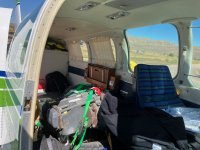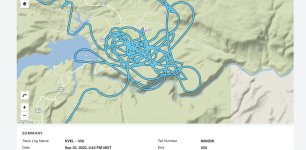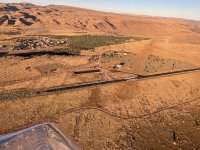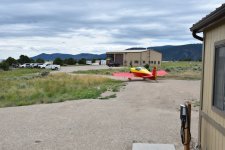VAF contributor Mahlon, has seen more than a couple of engines thru his life, and has kindly published this checklist (I hope he doesn't mind me publishing it here):
Engine Run-in. Written by Mahlon Russell.
CYLINDER RUN-IN INSTRUCTIONS FOR CHANNEL CHROME, CERMICROME, AND CERMINIL BARRELS
1) Install mineral oil in ALL normally aspirated engines and all Teledyne Continental turbocharged engines. Install AD oil in all Textron Lycoming turbo charged engines.
2) Start engine, run at 800 R.P.M.'s for three (3) minutes, shut down, check for leaks.
3) Start engine, run at 1,000 R.P.M.'s for three (3) minutes, shut down, check for leaks.
4) Cowl aircraft.
5) Start engine, run at 1,200 R.P.M.'s for three (3) minutes, shut down, park into wind.
6) Start engine, run at 1,400 R.P.M.'s for three (3) minutes, shut down, park into wind.
7) Start engine, run at 1,400 R.P.M.'s for five (5) minutes, run up to full power, check all engine parameters, retard power to 1,000 R.P.M. for one (1) minute, shut down.
8) Check for leaks The engine has now had it's Test Cell run time and is ready for other ground runs, taxi tests, adjustment runs, etc., observing the precautions from the post
• All runs should be made into the wind.
• At no time during these runs should CHT exceed 350F.
• Between all engine runs, allow adequate cool off time.
• Before proceeding to next run, you should be able to hold your hand on a rear cylinder
head for three to five seconds.
CYLINDER RUN-IN FOR STEEL, NITRIDED OR REBARRELED CYLINDERS
1) Install mineral oil in the engine.
2) Start engine, run at 800 R.P.M.'s for three (3) minutes, shut down, check for leaks.
3) Start engine, run at 1,000 R.P.M.'s for three (3) minutes, shut down, check for leaks.
4) Cowl aircraft.
5) Start engine, run at 1,200 R.P.M.'s for three (3) minutes, shut down, park into the wind.
6) Start engine, run at 1,400 R.P.M.'s for five (5) minutes, shut down, park into wind.
7) Start engine, run at 1,400 R.P.M.'s for ten minutes, shut down, park into wind.
8) Start engine, run at 1,400 R.P.M.'s for five (5) minutes, run up to full power, check all engine parameters, retard power to 1,000 R.P.M. for one (1) minute, shut down.
9) Check for leaks The engine has now had it's Test Cell run time and is ready for other ground runs, taxi tests, adjustment runs, etc., observing the precautions from the post
• All runs should be made into the wind.
• At no time during these runs should CHT exceed 350F.
• Between all engine runs, allow adequate cool off time.
Before proceeding to next run, you should be able to hold your hand on a rear cylinder head for three to five seconds.
This is some information on running after completing the above schedule:
Knowing this crucial information allows us to make practical decisions regarding ground runs and flight profiles from the new or newly overhauled engine point of view.
To put it simply, if we get the ring to cylinder interface too hot from too hard of running, lack of cooling or another reason we will glaze the cylinder walls and prevent actual break in from occurring. Because, we are dealing with multiple independent cylinders on the engine, these conditions can happen to one cylinder, all cylinders or anything in between on the same engine. So our job above all other aspect of engine operation during the break in phase, is to keep the cylinder's as cool as possible. If we do this we will not have any problems or issues with the engine as far as break in goes. During any and all ground runs we should limit the duration and actual temps we encounter to prevent glazing from happening. We tell our customers to keep all ground runs less than 10 minutes. Don't run the engine above 2000 RPM unless you are doing a momentary full power check, high speed taxi tests or actual take off runs. If the CHT goes above 350*F or the oil temp goes above 180*F at any point during the 10 minute max duration ground run, or at the expiration of the ten minute time limit, that run should be terminated. Then, park the aircraft faced into the wind and allow the engine to cool, until you can place your hand on the cylinder heads and barrels for 5 seconds without hurting or burning you hand and the cylinders feel relatively cool to the touch. After the engine has cooled, continue with the last run where you left off. Obviously, from what we have learned about temperature, running the engine more conservatively will not cause any problems and may even help the break in process but operating within these restrictions, on the ground, should prevent any glazing issues. These limitations apply to an engine that has had a test cell run before any ground runs are attempted. If your engine hasn't had any test cell time, then I can supply you with a ground run schedule, to replace the test cell run, which can be performed on the aircraft. If you want or need that information, just email me privately and I would be happy to send it along.
When it comes time to fly the aircraft, once again we want to observe the ground run rules, for taxi and warm up. Once we are ready to fly, we want to use full power for takeoff and initial climb and then we want to reduce power to climb power (normally around 85%) until we reach a safe altitude above the airport. Keep the climbs, as flat as possible, to maintain as much cooling as possible. Remember that heat is our major enemy and we can control that with climb speed. After establishing an appropriate altitude, reduce power to 65% to 75% (preferably 75 % if speed restrictions will allow it). If we see temps, exceeding 15% of our ground run limitations, in initial flights, we should reduce power to control those temps and land the aircraft. Then, double check all cooling associated equipment, repair as necessary if you find a defect, let the engine cool off and fly it again, taking up from where you left off, observing the same restrictions. The first flight shouldn't be any longer than 10 or 15 minutes maximum, even with good cooling that would allow a longer flight. The first flight is a "test flight" and after landing
you should do a thorough visual inspection of the engine and its installation, for leaks and any other operational issues like interference fits that showed up under power, chafing of lines etc. After the first flight issues are checked, we are ready for further flights under the same ground run and flight restriction's we have been observing. The key issue once again is heat. If we control the heat by power setting, airspeed, step climbing or any other means at our disposal we will not glaze the cylinders and we will successfully break the engine in. If we operate the engine at too low of a power setting, to seat the rings, we will not harm the engine or the eventual break in process, unless we develop enough heat to glaze the cylinders. In another words, operation at a low power setting, isn't a deterrent for break in unless we have the heat.
The amount of physical time we spend, at too low of a power setting to accomplish ring seating, does increase the available amount of engine operational time, that we could glaze the cylinders from excessive heat but it will not directly cause that heat unless there is something wrong or we screw up. The low power operation, without the heat, doesn't hurt anything, it is just wasted operational time, as far as, break in goes. To put it simply, if we ran the engine for 10 hours at 50% power it is unlikely that we would break the rings in, due to the low BMEP, but it is also unlikely that we would glaze the cylinders if we didn't get the engine and cylinders too hot. If we then operated the engine at 75% power for ten hours we would have the same chance of breaking the engine in successfully as we had before the ten hours at 50% power. But we have to understand, that ten hours at 50 % power is ten hours of, extra, wasted from a break in stand point, operational time where we could do something to cause the excessive heat that causes glazing, if we weren't paying attention. That is the only risk of low power operation as far as break in is concerned.
If you look at this scenario, you can understand how anyone is able to run an engine, in a test cell for extended periods, when we have new rings. It is because, in a test cell, we can control the cooling and if for some reason we can't, we terminate the runs in the cell to prevent glazing just like you should in the aircraft. If you control the cooling by limiting run duration or max temps encountered, with the engine installed on the aircraft, you are able to run the same as if the engine were in a test cell. Thus, extra cell time, on a new engine, isn't really necessary to prevent glazing or worrisome.








